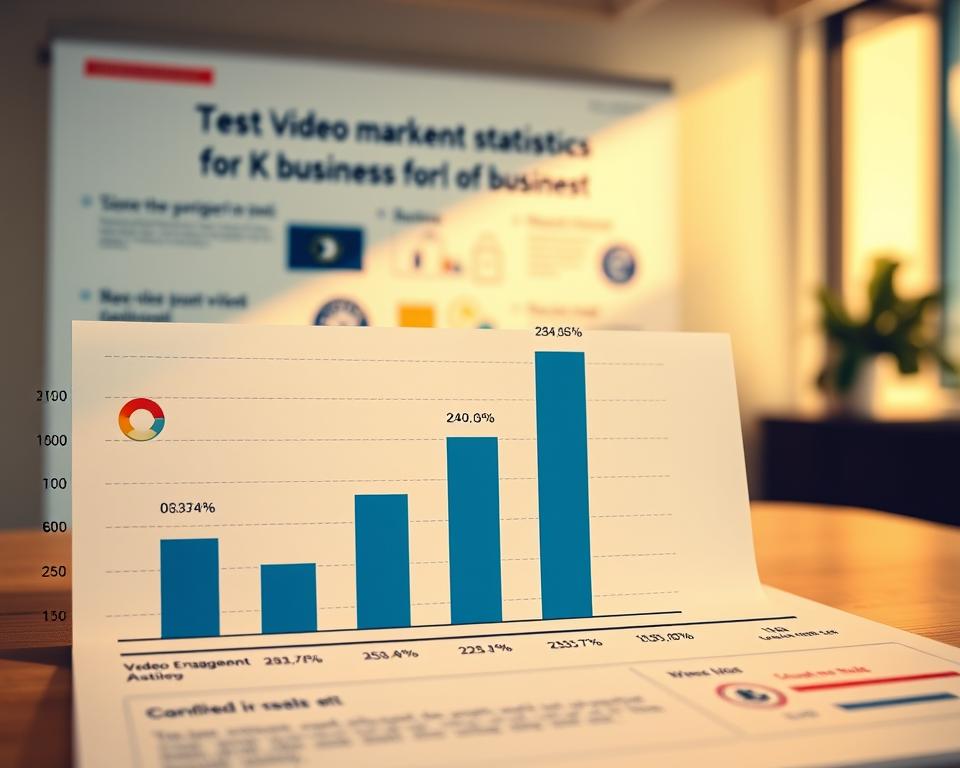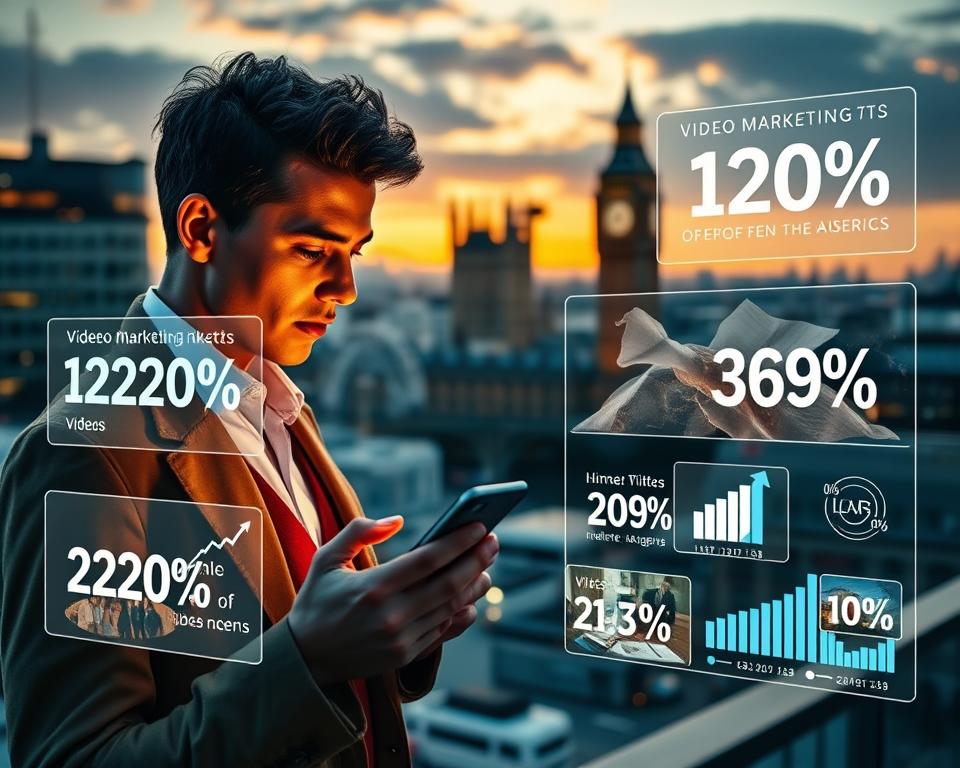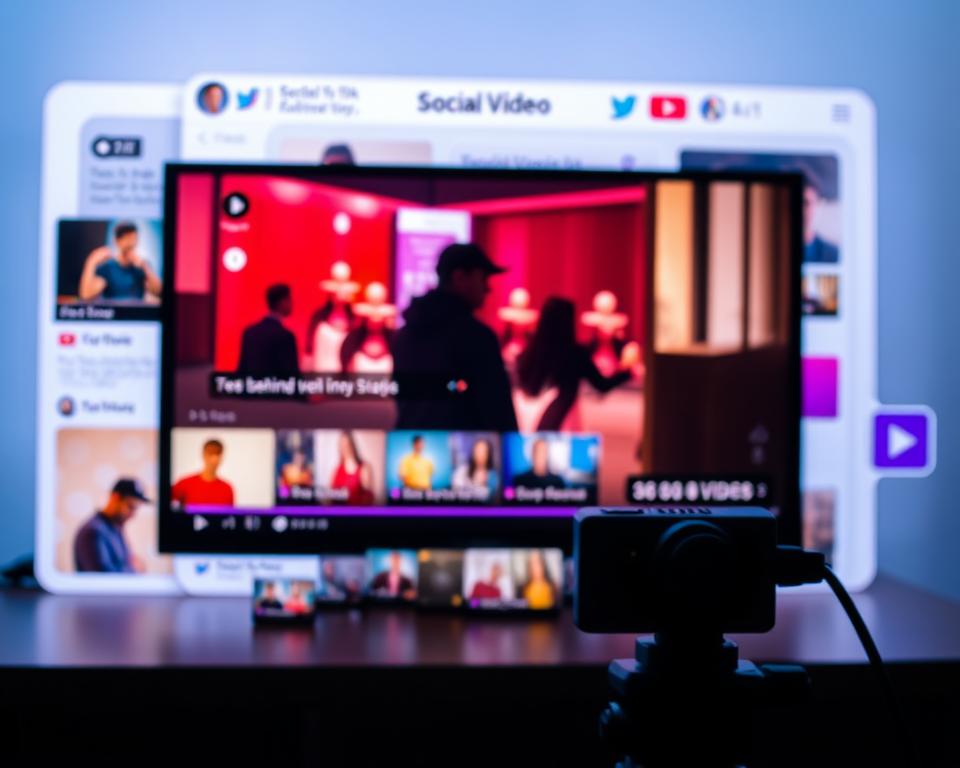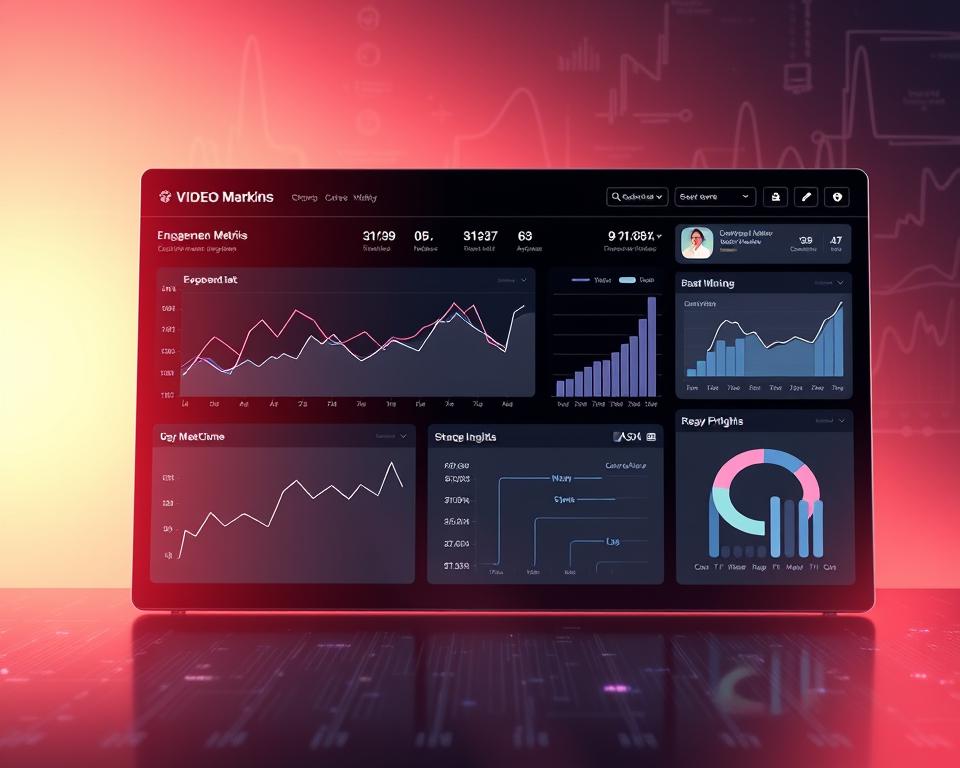
Why Video Content Dominates Social Media Marketing in the UK
Imagine this: 82% of all internet traffic in the UK is video. This shows a big change in how we use social media. Every day, people in the UK watch over an hour of online videos. This isn’t just a trend—it’s a must.
With 92% of UK marketers focusing on video, it’s clear the game has changed. They’re seeing the benefits.
Facebook has 44.8 million users, and YouTube has 35.6 million. Video’s popularity is clear. Marketers are getting results from video campaigns. They see a 66% increase in qualified leads.
Also, 93% of businesses have gained new customers through video. Even social platforms are favouring short-form videos. Brands need to adapt or risk being left behind.
The UK has 56.2 million social media users and 97.8% of the population online. The digital landscape is perfect for video. TikTok gets 49 hours of monthly engagement, and Instagram has 30.6 million followers.
Brands that ignore video risk missing their audience. The numbers show video is not just effective—it’s essential.
Key Takeaways
- 82% of UK internet traffic is video, driving social media marketing in the uk strategies.
- 92% of UK marketers prioritise video to boost uk social media trends engagement and sales.
- Video content increases qualified leads by 66%, outperforming static ads.
- Short-form platforms like TikTok and Instagram drive 1,200% more shares than text or images.
- 93% of businesses gained new customers through video, proving its ROI.
The Evolution of Social Media Marketing in the UK
The UK’s social media scene has changed a lot. Now, businesses use these platforms to grow their social media growth and boost their online presence. Let’s see how this change happened.
Key Milestones in UK Social Media Adoption
Major platforms have played a big role:
- Facebook: With 44.8m monthly users, it became the heart of digital interaction.
- YouTube (2007 launch): 35.6m users, starting the video marketing era.
- Instagram and TikTok: 30.6m and 3.7m users respectively, showing how visual content engages people.

How British Brands Have Adapted to Digital Platforms
86% of UK consumers engage with social ads
This has made brands rethink their plans. Local shops use Instagram stories, while big names like Tesco and Waitrose run specific campaigns. Even small businesses compete with big names online. This ensures they stay seen in a busy digital world.
The Shift from Text to Visual Content
Text updates are no longer the main focus. By 2023, 79.7% of UK ad spending went to digital. Retail media budgets are set to hit £1 billion by 2025, showing video’s importance. Brands now focus on short videos and live streams to grab attention. It’s clear: video is key to success.
The Power of Video: Statistics That Tell the Story
Video content is more than just popular; it’s a game-changer for UK businesses. It boosts brand recall by 85% over text. Also, digital marketing services using video see 66% more qualified leads.
Over 93% of marketers gained new customers through video campaigns. Social videos outperform text by a staggering 1,200% in shares. This makes them key for engagement.
“93% of marketers gained new customers through video marketing.”

Platform preferences vary but matter. 51% of UK consumers follow cultural trends on Facebook and Instagram. 37% favour YouTube and TikTok.
Short-form video dominates: 81% of users want more from brands. By 2025, short-form content will outspend all other formats in budgets. 73% of video marketers use explainer videos, a tactic 96% of viewers find helpful.
Numbers back this up. 87% of marketers report direct sales boosts from video ads. 86% see web traffic rise, and 90% note higher brand awareness. Even brief views matter: 74% of campaign value comes from users watching under 10 seconds.
With 68% of non-video users planning to adopt video by 2025, the shift is unstoppable.
For UK businesses, video isn’t optional—it’s essential. The stats are clear: video drives results. From lead generation to sales, it’s the tool digital marketing services can’t ignore. With 98% of marketers committed to video, the message is loud and clear.
Why British Consumers Engage More with Video Content
British people love video content because it fits their fast lives. They enjoy short clips on TikTok and detailed tutorials on YouTube. Social media campaigns with quick, eye-catching videos do better than those with just text or images.

Cultural Factors Influencing Content Consumption
Brits love stories that get straight to the point. Instagram shows 83% of users find products through videos, proving videos are key in marketing strategies. Brands like Spotify and Mango win by being funny and real, matching what UK viewers like.
Attention Spans in the Digital Age
Research by Dr. Gloria Mark says we now focus for just 47 seconds. Videos are perfect for this, as static posts can’t compete. Gen Z, spending three hours a day on TikTok, wants content that’s quick and easy to share.
Emotional Connection Through Moving Images
Stories that touch our hearts make us want to share. Brands that use real customer stories or sneak peeks build trust. For example, Mango’s work with influencers creates stories that connect with viewers.
The Trust Factor: Authenticity in Video
Being real is important. With 71% of UK adults seeing Facebook ads every day, brands must be genuine. Using clips from users or unscripted interviews makes content believable. This makes people more likely to act. Videos show real life, giving them an advantage over traditional ads.
Types of Video Content Driving Engagement for UK Businesses
Choosing the right video formats is key to good social media management. In the UK, 72% of customers prefer video over text. Let’s look at the top video types that boost engagement.

Brand Storytelling Videos
Stories that share values create strong bonds. Innocent Drinks’ videos focus on sustainability, appealing to eco-aware viewers. These stories turn viewers into loyal fans.
Product Demonstrations and Tutorials
Interactive tutorials encourage action. Dyson uses YouTube to show off product features, helping 65% of users find solutions. Short tutorials can turn browsers into buyers.
Customer Testimonials with a British Touch
Feedback in local dialects feels real. John Lewis’ festive ads mix storytelling with British humor. This makes testimonials feel like part of the community.
Behind-the-Scenes Content
Being open builds trust. BrewDog’s factory tours and employee interviews make brands more relatable. This type of content boosts brand affinity and shares.
Live Streaming Success Stories
Live interaction creates a sense of urgency. Gousto’s live cooking shows increase sales by 30%. Live streams are a key part of social media strategies.
| Video Type | Key Benefit | Statistic |
|---|---|---|
| Brand Storytelling | Emotional connection | 72% prefer video for product info |
| Product Demos | Problem-solving | 65% use YouTube for solutions |
| Testimonials | Authenticity | 93% of marketers use video |
| Behind-the-Scenes | Trust-building | 86% of businesses use video |
| Live Streaming | Real-time engagement | Live streams increased sales by 30% |
“Video is the cornerstone of modern marketing. It’s not just about posting—it’s about telling stories that matter.”
Platform-Specific Video Strategies for UK Audiences
Mastering social media marketing in the UK means using different strategies for each platform. Here are the best ways to use videos on top channels based on uk social media trends:

| Platform | Optimal Video Length | Best Practices | Key Stats |
|---|---|---|---|
| 1-2 minutes | Use Stories with sound for higher conversions | 80% of Facebook Stories with sound drive better lower-funnel results | |
| 15-30 seconds | Focus on Reels and Stories; prioritise captions | 91% of users watch videos weekly; 43% prefer Stories | |
| 30 seconds or less | Embed short clips with CTAs | Tweets with video get 10x more engagement | |
| TikTok | 15-60 seconds | Create viral-friendly, trend-aligned content | Short-form platforms dominate brand storytelling |
| YouTube | 2-5 minutes | Optimize for search with detailed tutorials | 74% of users use it for product discovery |
To keep up with uk social media trends, know where your audience hangs out. For instance, LinkedIn is great for professional 2-3 minute videos in B2B sectors. Try different posting times, like mornings for LinkedIn and evenings for TikTok. Also, 62% of users interact more with brands using native formats. Be quick to adapt—AI tools can help make content personal and fresh across all platforms.
Budget-Friendly Video Production Tips for Small UK Enterprises
Creating great video content doesn’t need a big budget. Small UK businesses can make powerful campaigns with clever marketing strategies and easy-to-use tools. We’ll look at ways to get professional results without spending too much.

Essential Equipment for Quality Results
- Begin with smartphones—most modern ones can shoot 4K video.
- Get a portable ring light or use natural light to improve your shots.
- Choose affordable microphones like Rode’s NT-USB or lapel mics for clear sound.
- Use everyday items: books can be stabilisers, and free tools like Adobe Premiere Rush or iMovie can refine your clips without cost.
DIY vs Professional Production: When to Invest
Choose wisely between doing it yourself or hiring professionals:
- DIY is good for quick tutorials, social media clips, or customer feedback.
- For big projects like product launches or brand films, consider UK studios like Shot Blast Media for a polished finish.
Investing in digital marketing services is wise for critical campaigns.
Maximising Content Value Through Repurposing
One video can power many campaigns. Turn a 5-minute interview into 10 TikTok clips, Instagram Stories, and LinkedIn highlights. The GaryVee Content Model shows repurposing can increase ROI—use the same footage on different platforms while adjusting the message.
A bakery in Manchester used a short video to make 15-second reels, email snippets, and animated GIFs from photos. This reached 30% more customers without extra filming.
Measuring Success: Key Metrics for Video Marketing Campaigns

Tracking the right data is key to making video campaigns successful. It helps grow social media presence and boost online presence. Here’s what to focus on:
| Metric | What It Measures |
|---|---|
| View Count | Total audience reach |
| Play Rate | Initial viewer interest |
| Engagement Percentage | How much of the video was watched |
| Share Rate | Social amplification success |
For online presence gains, look at these engagement indicators too:
- Click-through rates (CTR) to CTAs
- Conversion rates to sales or sign-ups
- Qualitative feedback from comments
Here are tips for tracking conversions:
- Use UTM parameters for campaign links
- Link video CTAs to analytics platforms
- Test A/B variants of calls to action
Calculating ROI is important. It compares costs to outcomes. A study found 88% of marketers see positive video ROI. For example, 70% of UK businesses plan to increase their budgets here.
Direct gains include sales uplift. Indirect benefits are brand awareness. Track metrics over time to improve strategies.
Common Pitfalls in Video-Based Social Media Strategies
Effective video marketing is more than just sharing clips. Many UK businesses miss important steps that can ruin their social media campaigns. Let’s look at common mistakes and how to steer clear of them.

- Ignoring audience preferences: 33% stop watching after 30 seconds. Make sure your content fits the platform—like short TikTok clips versus longer Instagram videos.
- Poor storytelling: Emotional stories get shared more. A coffee chain’s success shows that stories about their beans do better than generic ads.
- Mobile neglect: 85% of UK users watch videos on phones. Make sure your videos play automatically and look good on small screens.
- Overpromoting: Stick to the 80/20 rule. Only 12% of viewers want constant sales; share tips or behind-the-scenes content first.
- Ignoring analytics: 40% of uk businesses don’t track performance. Use tools like Instagram Insights or YouTube Analytics to improve your strategy.
- Weak engagement: 60% of consumers expect quick responses. Answer comments and host live Q&As to build loyalty.
Real examples show the importance of these tips. A retailer failed because they ignored mobile optimisation, while a fashion brand increased sales by focusing on user-generated content. By learning from these, uk businesses can turn mistakes into chances. Remember, it’s all about adapting to what viewers want and following platform rules to stand out online.
Future Trends in Video Content for Social Media Marketing in the UK

New technologies are changing how brands use uk social media trends. Augmented reality (AR) and virtual reality (VR) will let people try products online. AI tools will make social media management easier by automating editing and making content personal.
Short videos are key: 35% of UK viewers like 15-second clips. This means brands must tell stories quickly and effectively.
- Interactive videos with branching narratives boost engagement by 40%.
- AI-generated scripts and voiceovers cut production costs by up to 30%.
- AR filters on platforms like Instagram drive 2x higher user interaction.
“Post-pandemic, audiences crave authenticity. Brands using real customer stories in video content see 93% higher trust ratings.” – Sarah Carter, Head of Digital Strategy at Unruly
After lockdown, 71% of UK consumers want ads that feel personal. TikTok’s high engagement shows short videos are popular. YouTube’s long videos build trust.
Experts say we’ll see more ways to buy things from videos by 2025. Voice-optimised titles and closed captions are also on the rise for better accessibility. As more people watch TV on their screens, content must be flexible.
Social media management needs to keep up with these changes to stay ahead.
Conclusion: Embracing Video to Transform Your Social Media Presence
Video content is not just a trend; it’s essential for modern social media strategies in the UK. With 73% of consumers preferring video to learn about brands, businesses that ignore this trend will fall behind. Videos help cut through digital noise, providing engagement that static posts can’t offer.
Creating effective marketing strategies begins with knowing your audience. Start by repurposing existing content or investing in clear storytelling. Even with a small budget, DIY tools can help. But, professional production ensures your content looks polished. Always protect your content by clarifying ownership agreements.
As remote work changes how we consume, video remains a key way to connect with audiences. Focus on being authentic—customers prefer real moments over perfect ones. Use metrics like watch time and conversions to improve your campaigns. With new trends like AR and interactive content coming, it’s time to adapt.
Don’t wait to start using video in your social media strategies. Whether you’re a new startup or an established brand, video is key to staying visible. Plan your budget carefully, stay flexible, and let your brand’s voice be heard. Video is more than a tool; it’s your path to growth in today’s visual world.